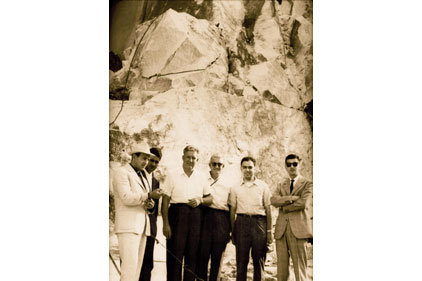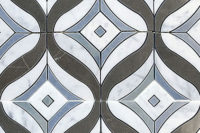The son of a feather merchant, Leon Zanger was born in Belgium in the late 1920s, but world events would conspire to bring him to the New World. Perceiving the threat posed by Germany in 1940, Zanger's father orchestrated a family exodus from Europe, which is how Leon Zanger, at age 12, ended up in the then-neutral Portugal, where he saw workers paving the streets with marble. When he told his mother that Portugal must surely be rich beyond measure, she explained to him that it wasn't; it was just that marble was inexpensive and plentiful there. It was a story that Zanger never forgot.
By the time his family had arrived in America, Zanger had lived throughout Europe and Africa, and had gained fluency in Flemish, French, Portuguese, German and English. It was this affinity for languages which attracted the attention of an export firm in New York, which hired him to create its new import division. Recalling the memory of abundant Portuguese marble -- and knowing the handsome prices it commanded in America -- he quickly made contact with Portugal's largest marble company and began to import their stone. But since his employer wouldn't extend credit to customers, Zanger struck out on his own, forging a partnership with Walker, a former co-worker. Each contributed $500 to the effort -- and Walker & Zanger was born.
It wasn't long before Zanger perceived a promising opportunity to bring a new design sense to America, and took the initiative to realize it. An obscure two-line listing from a furniture store in the Sunday New York Post advertised glass-topped tables for $39. Armed with his sample bags full of marble, Leon approached the store owner directly and proposed that the store sell the same tables, only with genuine marble tops for the same price, at a comparable profit. The store owner placed an order for $10,000 worth of tabletops on the spot.
Zanger had a sizable order, but his fledgling company had no credit with suppliers. He quickly cabled his story to his old friends at Portugal's largest marble firm, to which he received the reply: "Congratulations on going into business for yourself. Your credit with us is unlimited; sell as much as you can." When the $39 marble-topped tables eventually went on sale, the store had lines around the block, and sold out its entire stock in 90 minutes. More orders followed, including from Macy's and Gimbels, and by the end of its first year in business, Walker & Zanger had earned profits of $1 million.
To keep pace over the years, Walker & Zanger opened offices in North Carolina, Florida, Italy, Germany, Puerto Rico, Toronto and Montreal; with every single year witnessing an increase in profits.
Once again, Zanger spotted an opportunity -- this time in southern California -- and tasked his trusted office manager, John Iberti, to explore the possibilities in the non-unionized Golden State. With the help of his brother-in-law, Lou Bastone, Iberti brought the Walker & Zanger name to the Los Angeles area in 1958. Originally working out of his house, he grew the business exponentially to the contractors of the postwar construction boom. Together, the two expanded beyond marble, importing decorative ceramic tiles from places like Japan and Spain that surpassed the beauty of anything available in the U.S. at the time, and fulfilling the needs of the architects and designers who sought newer and more sophisticated looks for their projects.
In 1963 Walker & Zanger became the first company to bring to America thin-sliced Italian marble. At a mere 3/8 inch thick, it eliminated the magnificent stone. The "Martile" (a name coined by Walker & Zanger) was both affordable and easy to install, sparking a design revolution. It was just one of numerous Walker & Zanger firsts in America, including the introduction of 11/4-inch granite slabs for kitchen countertops; and the introduction of French limestone, Brazilian granite, and Filipino and Indonesian marble. Over the years, by insisting on visiting exotic quarries first-hand, Walker & Zanger would introduce Americans to hundreds of imported stone varieties.
In 1969, Zanger bought out his partner Marvin Walker and promoted Iberti to partner of the West Coast operation, which continued the Walker & Zanger tradition of year-over-year growth. In the early 1970s, the newly-named Walker Zanger company was recruited to provide the historically-accurate stone for J. Paul Getty's Pompeiian Vila, housing his Ancient Art Museum in Malibu, CA -- even going so far as to source stones from the Medici family and the Vatican. It was one of many landmarks to be graced with Walker Zanger stone and marble, including the Kimball Art Gallery in Texas, the Bellagio Hotel in Las Vegas, the Borgata Casino in Atlantic City, NJ, and the NationsBank Tower in Charlotte, NC.
After Iberti retired in the late 1990s, the Zanger family bought out the West Coast operation, uniting the two companies under a single-family umbrella. This merger fueled the opening of the company's offices and showrooms in Manhattan, Fort Lauderdale and Charlotte.






